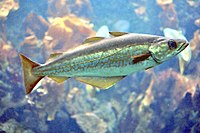
Photo from wikipedia
The first records of walleye pollock Gadus chalcogrammus Pallas, 1814 in the seas of the Siberian Arctic (the Laptev Sea, the Kara Sea, the southeastern Barents Sea), are documented. Information… Click to show full abstract
The first records of walleye pollock Gadus chalcogrammus Pallas, 1814 in the seas of the Siberian Arctic (the Laptev Sea, the Kara Sea, the southeastern Barents Sea), are documented. Information about the external morphology (morphometric and meristic characters), photos of sagittal otoliths and fish, and data on the sequences of the CO1 mtDNA gene are presented. The results of a comparative analysis indicate that walleye pollock caught in the Siberian Arctic do not differ in principle from North Pacific and North Atlantic individuals. Previous conclusions about the conspecificity of the walleye and Norwegian pollock Theragra finnmarchica are confirmed. New captures of walleye pollock in the Siberian Arctic allow us to formulate a hypothesis about its continuous species’ range from the coasts of Norway in the North Atlantic to the coasts of Korea, Japan, and California in the North Pacific. The few records of walleye pollock in the North Atlantic originate from the North Pacific due to the transport of early pelagic juveniles to the Arctic by currents through the Bering Strait and further active westward migrations of individuals which have switched to the bentho-pelagic mode of life.
Journal Title: Journal of Marine Science and Engineering
Year Published: 2021
Link to full text (if available)
Share on Social Media: Sign Up to like & get
recommendations!